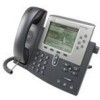Cisco 7962G Administration Guide - Page 156
Eliminating DNS or Other Connectivity Errors, Checking Power Connection, Erase, System > Server
 |
UPC - 882658140341
View all Cisco 7962G manuals
Add to My Manuals
Save this manual to your list of manuals |
Page 156 highlights
Cisco Unified IP Phone Resets Unexpectedly Chapter 9 Troubleshooting and Maintenance Eliminating DNS or Other Connectivity Errors If the phone continues to reset, follow these steps to eliminate DNS or other connectivity errors: Procedure Step 1 Step 2 Step 3 Step 4 Step 5 Step 6 Use the Erase softkey to reset phone settings to their default values. See the "Resetting or Restoring the Cisco Unified IP Phone" section on page 9-13 for details. Modify DHCP and IP settings: a. Disable DHCP. See the "Network Configuration Menu" section on page 4-5 for instructions. b. Assign static IP values to the phone. See the "Network Configuration Menu" section on page 4-5 for instructions. Use the same default router setting used for other functioning Cisco Unified IP Phones. c. Assign a TFTP server. See the "Network Configuration Menu" section on page 4-5 for instructions. Use the same TFTP server used for other functioning Cisco Unified IP Phones. On the Cisco Unified Communications Manager server, verify that the local host files have the correct Cisco Unified Communications Manager server name mapped to the correct IP address. From Cisco Unified Communications Manager, choose System > Server and verify that the server is referred to by its IP address and not by its DNS name. From Cisco Unified Communications Manager, choose Device > Phone > Find and verify that you have assigned the correct MAC address to this Cisco Unified IP Phone. For information about determining a MAC address, see the "Determining the MAC Address for a Cisco Unified IP Phone" section on page 2-13. Power cycle the phone. Checking Power Connection In most cases, a phone will restart if it powers up by using external power but loses that connection and switches to PoE. Similarly, a phone may restart if it powers up by using PoE and then gets connected to an external power supply. Cisco Unified IP Phone 7962G and 7942G Administration Guide for Cisco Unified Communications Manager 6.1 9-8 OL-14625-01















